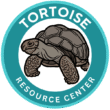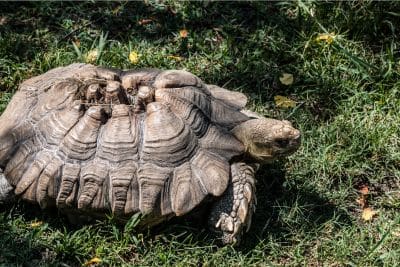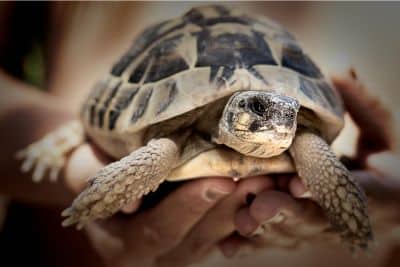Tortoises, those prehistoric-looking creatures that carry a shelter on their backs, are as enigmatic as they are ancient. They represent a unique group within the reptile kingdom and are known for their widespread native origins and unusual anatomies.
With such a diverse range of external stimulus found in their natural habitat, it makes perfect sense that tortoises have adapted their behavior to enable them to survive in their environment, but what exactly does this look like, and how does this impact their interactions with other tortoises and their keepers?
Whether you’re a tortoise enthusiast, a novice keeper, or a seasoned herpetologist, I’ve compiled this guide to equip you with some fascinating insights into the curious way these incredible creatures behave and how they interact with each other, as well as with humans.
Behavior and Intellect
Stereotypically, tortoises are slow and steady, of low intelligence and seemingly lacking in mobility or agility. But, as is usually the case, there is more to their abilities than meets the eye.
Their adaptations have made them well equipped to tackle the extremities of the terrain of their natural habitats, seek refuge from extreme weather conditions and overcome obstacles that get in their way. Did you know, for example, that although tortoises are unable to swim, the buoyancy of their shells and ability to survive for long periods without food or water has enabled them to migrate to isolated islands?
Climbing
Although they are not built for agile or vertical climbing, tortoises have strong, sturdy legs and claws which help them to gain traction on rough surfaces. This allows them to climb over obstacles in their path, such as rocks, low walls, or uneven terrain.
Tortoises are not the most adept climbers but that’s not to say they don’t, and their abilities should never be underestimated. The Horsefield tortoise (also known as the Russian tortoise) is known for their ability to climb and dig under fences to escape their enclosures.
Walking
Although all tortoises are slow movers, their speeds can vary among different species. On average, they move at a pace of about 0.2 to 0.5 kilometers per hour (0.1 to 0.3 miles per hour). Larger species, like the Sulcata and the Galapagos tortoise, move even slower due to their size and weight.
Despite their slow speed, wild tortoises can roam up to a kilometer each day when motivated to search for food, water, or a mate.
Burrowing
Burrowing is a natural behavior for tortoises and is one of the main ways they seek shade from the sun or shelter from cold or wet weather.
As cold-blooded animals, burrowing into the earth during the intense heat of the day or when air temperatures drop at night and during the cold winter months helps them maintain a steady internal body temperature. This is known as thermoregulation.
Desert tortoises often burrow at night to escape the cold. By digging into the ground, they can reach depths where the temperature remains more stable and insulated from surface cold.
They also dig into the earth to find moisture. This helps them to stay hydrated during long periods of drought.
Tortoise Intelligence
Tortoises exhibit a range of cognitive skills. In fact, their surprisingly sophisticated level of intelligence enables them to navigate often-challenging habitats, find food, and avoid threats.
Studies have shown that tortoises have a good memory. For instance, they can remember feeding locations and the way back to their shelters. Their ability to remember important locations even after long periods suggests a robust spatial memory.
Tortoises have also been observed solving simple problems in experimental settings, such as navigating mazes or learning how to push through barriers to reach food. This suggests they can learn and remember solutions to problems.
My tortoises appear to have some level of social recognition. For example, they respond to my voice, walking toward me as I approach. Conversely, they are unresponsive when unfamiliar people are nearby.
Sleeping
Tortoises are diurnal, meaning they are active during the day and sleep at night. They sleep in secluded spots or burrows for about 8-12 hours per night, but this can vary depending on the species and the temperature of their environment.
They typically withdraw their limbs and head into their shells for protection. This natural defense mechanism helps keep them safe while they are vulnerable during sleep.
Aside from nightly sleep, tortoises may also have periods of rest during the day, especially in hot weather, when they seek shade to cool down and conserve energy.
Are You Starving Your Tortoise?
Save 10% on premium tortoise food and supplements from Tortoise Resource Center on Amazon now using code BUYNOWGET10

Sulcata Vitamin & Mineral Topper Supplement
30-Day Supply | 2 oz (56 g)
$24.99

Baby Sulcata Tortoise Superfood Powder
30-Day Supply | 2.5 oz (70.8 g) Bag
$24.99
Hibernation
In colder months and more temperate climates, some species can sleep for extended periods to conserve energy. This is known as hibernation and is largely dependent on the species and their native climate.
Most commonly, species that originate from the Mediterranean with temperate regions and seasonal temperature fluctuations will hibernate. Species that are native to consistently warm climates may not hibernate at all.
During hibernation, also known as brumation and a specific term used for reptiles, a tortoise’s bodily functions slow down, including their heart rate and breathing. They may spend this period buried in the ground or in other insulated, protected spaces to maintain a stable, cooler temperature and conserve energy. How long they hibernate, depends on the species and the climate from which the originate.
For tortoises, brumation is typically triggered by shorter daylight hours and lower temperatures. During this period, they might bury themselves in the ground or find shelter in safe, insulated places.
While in brumation, tortoises might wake occasionally to drink water but generally do not eat.
Tortoise Interactions With Each Other
Tortoises are solitary by nature and spend much of their life in the wild alone, indicating that they don’t need companionship as other animals do.
Due to their solitary nature tortoises don’t get lonely in the conventional sense. In the wild, enrichment activities come in the form of protecting themselves against predators, foraging for food and exhibiting dominance in mating situations.
These adaptations mean that captive tortoises need enrichment activities such as a stimulating environment and interaction with familiar humans to avoid boredom, stress, and obesity.
When they do come together, its mainly for breeding purposes or occasionally when there is an abundance of food in a particular area.
Interaction During Breeding
Captive tortoises can demonstrate territorial behavior such as aggression or physical confrontations when they live in the same enclosure. This can lead to stress and should be monitored closely especially during mating season.
If I’m housing two or more tortoises’ together, I not only double the size of the pen, but also provide multiple hiding spots, feeding areas, and basking spots. This seems to minimize competition and stress.
Fun Fact:
A group of tortoises is called “a “creep.” This term is used to describe a collection of tortoises together, although it’s not very commonly heard due to their solitary nature.
Interactions with Humans
Some of the more common tortoise species including Russian tortoises, Greek tortoises and Hermann’s are curious by nature and quickly learn to become less timid.
With good husbandry skills, a regular feeding and maintenance schedule, and a little bit of patience, a captive tortoise may begin to follow their keeper, bask in their presence, or respond to their owner’s voice.
Some even learn to enjoy physical contact such as a shell or head rub and most will learn to take food from their keeper.
Because of their 95% solo endeavors, tortoises are not affectionate in the conventional sense like pets such as dogs might be.
However, over time, I have noticed that my tortoises have developed trust by moving toward me as I approach their enclosure and accepting food from me when I hand feed them.
This type of behavior takes time, perseverance, and commitment on the keeper’s part. It can be frustrating – especially for children – if your pet tortoise simply freezes or retreats into its shell as you approach.
My advice is to keep calm, talk in a gentle tone and keep to regular feeding, bathing, and cleaning times. Tortoises love routine and most will learn to adapt.
Communication
Despite being solitary creatures, tortoises exhibit various sounds and behaviors plus physical cues to communicate. This is particularly noticeable during mating season or when there is a need to defend territory.
Physical Cues
Body language such as head bobbing and posturing and aggressive behavior such as shell ramming and biting are all primary modes of communication for tortoises. These are mostly intended to assert dominance, defend territory, or demonstrate interest in mating.
Head bobbing is also a form of communication for tortoises. I often see my tortoises bobbing their heads as I approach their enclosure and when I offer them food.
Males will also bob their head to show interest and readiness for mating and to establish dominance over competitors. It can also be used as a form of intimidation and to assert territorial claims.
Additionally, during courtship, tortoises often engage in physical contact. This includes the male ramming the female’s shell or gently biting her legs. These actions help to initiate mating and communicate readiness and interest.
Vocal Communication
While tortoises are not known for being noisy animals, they do make sounds, especially during mating, when distressed, or if threatened. These sounds can include grunting, hissing, or even squeaking.
Fun Fact:
Gopher tortoises are known to excrete pheromones during mating. This is thought to communicate their interest and availability to potential mates.
For more fascinating facts and information about tortoises, why not head over to my post about Tortoise FAQs Health and Anatomy by clicking the link.
Citations
Research Gate – Tortoise Anatomy
Georgia Public Broadcasting – Tortoise Communication


